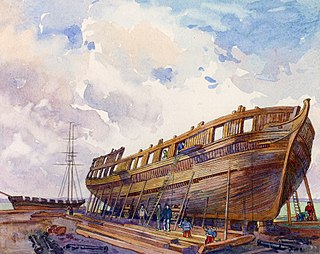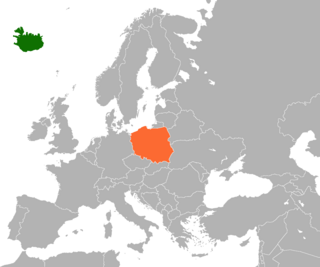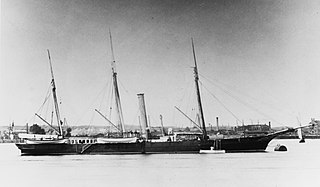
Frederick Temple Hamilton-Temple-Blackwood, 1st Marquess of Dufferin and Ava,, was a British public servant and prominent member of Victorian society. In his youth he was a popular figure in the court of Queen Victoria, and became well known to the public after publishing a best-selling account of his travels in the North Atlantic.
A royal yacht is a ship used by a monarch or a royal family. If the monarch is an emperor the proper term is imperial yacht. Most of them are financed by the government of the country of which the monarch is head. The royal yacht is most often crewed by personnel from the navy and used by the monarch and their family on both private and official travels.

Letters From High Latitudes is a travel book written by Lord Dufferin in 1856, recounting the young lord's journey to Iceland, Jan Mayen and Spitzbergen in the schooner Foam.

USS Mayflower (PY-1) was a 275 ft (84 m), 2,690 t (2,650 LT) motor vessel originally built as a private yacht that went on to serve in a variety of military, governmental, and commercial roles.

A & J Inglis Limited, was a shipbuilding firm founded by Anthony Inglis and his brother John, engineers and shipbuilders in Glasgow, Scotland in 1862. The firm built over 500 ships in a period of just over 100 years. Their Pointhouse Shipyard was at the confluence of the rivers Clyde and Kelvin. They constructed a wide range of ships, including Clyde steamers, paddle steamers and small ocean liners. In wartime, they built small warships, and in the period after World War II, they built a number of whalers.

The Naval Shipyards were naval shipbuilding facilities used by the Provincial Marine and the Royal Navy in York, Upper Canada. The naval shipyards were ordered by the Lieutenant Governor of Upper Canada John Graves Simcoe in 1793, and were opened in 1798.

USS Williamsburg was a US Navy gunboat. A former private yacht, it also served as a presidential yacht from 1945 to 1953.
Foam is a substance that is formed by trapping gas bubbles in a liquid or solid. Foam may also refer to:

Eleven ships of the French Navy have borne the name Cassard in honour of Jacques Cassard:

HNoMS Honningsvåg was a naval trawler that served throughout the Second World War as a patrol boat in the Royal Norwegian Navy. She was launched at the North Sea harbour of Wesermünde in Hanover, Germany in February 1940 as the fishing trawler Malangen and was captured by Norwegian militiamen at the North Norwegian port of Honningsvåg during her maiden fishing journey to the Barents Sea. Having taken part in the defence of Norway in 1940 she spent the rest of the war years patrolling the ocean off Iceland. She was decommissioned in 1946, sold to a civilian fishing company in 1947 and scrapped in 1973.
Empire Caribou was a 4,861 GRT cargo ship which was built in 1919 for the United States Shipping Board (USSB) as Waterbury. She was sold in 1920 to the American Star Line and renamed Northern Star. In 1923, she was sold to American Sugar Transporters Inc and renamed Defacto. In 1941 she was passed to the Ministry of War Transport (MoWT) and renamed Empire Caribou. On 10 May 1941, she was torpedoed and sunk by U-556.

Iceland–Poland relations are the diplomatic relations between Iceland and Poland. Both nations are members of the EEA, NATO, OECD, OSCE, CBSS, COE and the UN.
The steamer SS Ercolano was a passenger steamship which plied the waters of the Mediterranean in the 1850s.

HMS Southern Prince was a motor ship that was built in 1929 as the refrigerated cargo ship Southern Prince. She was commissioned into the Royal Navy in 1940 as a minelayer. She became a headquarters ship and then an accommodation ship in 1944, was a fleet training ship in 1945, and returned to civilian trade in 1946. In 1947 she was sold to Italian owners who had her refitted as a passenger ship and renamed her Anna C. From 1952 she was a cruise ship. She was scrapped in 1972.

Corse, initially named Napoléon before its second commission, was a sail and steam experimental schooner, initially commissioned as a mail steamer. Largely overperforming her specifications and an excellent sailor, she was purchased by the Navy and commissioned to serve as an aviso, becoming the first propeller ship in service in the French Navy. She took part in the Crimean War and ferried Prince Napoléon to Iceland in 1856. She was eventually broken up in 1902.

SMS Prinz Adalbert was a steam corvette of the German Kaiserliche Marine, the second and final member of the Leipzig class. She was laid down in 1875 at the AG Vulcan shipyard in Stettin, was launched in June 1876, and was commissioned into the fleet in August 1877. Originally named Sedan after the Battle of Sedan of the Franco-Prussian War, she was renamed Prinz Adalbert to avoid antagonizing France in 1878, less than a decade after the battle.

SMS Grille was an aviso of the Prussian Navy built in France in the mid-1850s as part of a naval expansion program directed by Prince Adalbert of Prussia, who saw the need for a stronger fleet. She was authorized in 1855 in the aftermath of the First Schleswig War, which had demonstrated the weakness of the Prussian fleet. Grille was the first screw propeller-driven steamship to be built for Prussia; all earlier steam-powered vessels had been paddle steamers.

Joseph Foster Stackhouse was a British traveller and would-be explorer who, in 1911, led an expedition to the Arctic island of Jan Mayen. In 1914 he attempted to organise a British expedition to the Antarctic, but this was prevented by the outbreak of the First World War. He died in the sinking of the Lusitania.














